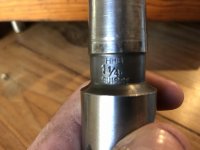Tooling question - Morse Taper?
OK, so I took these bits and cleaned them off with some denatured alcohol so I could better tell what I have... I also measured at the biggest and smallest Diameter of the taper with some blade calipers (see the pic). It appears that the large diameter is around 0.930in and the small diameter is around 0.775 at the small end of the taper. The taper length is around 3 1/4" or so...
Based on these measurements, I'm starting to think these are #3 morse taper and not B&S. The reason why I was assuming it was B&S is the lack of a tang on the end. At the time, I didn't realize that MT can come with or without the tang but read later that they are tapped for a draw bar in some applications. Also, from your table, there is no B&S numbers anywhere near the range of measurements that I'm recording. The measurements are close to a #3MT however. Any thoughts on this?
As for material and finish, there is a mark on each bit shank that says H.H.B. I'm not sure what that means, or how to figure out if these are high speed steel, carbide, etc. Any thoughts.
There is also the word Suisse stamped into the shank, which I think indicates that they are made in Switzerland.
And finally, it's not clear if I have end mills, or some kind of spiral reamers.. The end geometry looks more like an end mill than any reamer that I've seen... Any thoughts on this?
Any assistance will be greatly appreciated.
Taper Dia:
Big end --- 0.930
Small end-- 0.775
The sizes are as follows:
Drills:
1 1/4"
1 1/8"
1"
15/16"
7/8"
13/16"
3/4"
5/8"
11/16"
9/16" -- Broken
1/2"
3/8"
5/16" -- Broken
End Mills (HHB):
1 1/8"
1"
15/16" -- New still in wax
7/8"
13/16" -- New Still in wax
11/16" -- New still in wax
3/4"
9/16" -- New still in wax
1/2"
7/16" -- Broken
3/8"
5/16"
1/4" -- new in wax
1/4" -- Duplicate
1/4" -- Duplicate
1/4" -- Duplicate
















